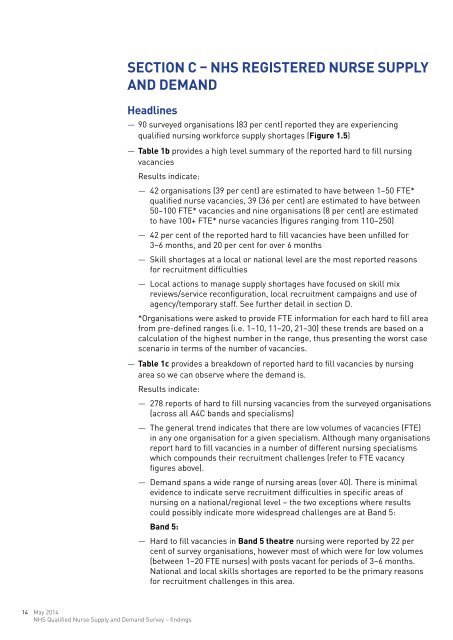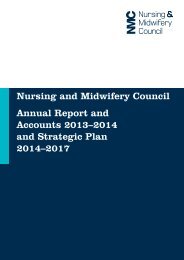NHS-qualified-nurse-supply-and-demand-survey-12-May1
NHS-qualified-nurse-supply-and-demand-survey-12-May1
NHS-qualified-nurse-supply-and-demand-survey-12-May1
- No tags were found...
Create successful ePaper yourself
Turn your PDF publications into a flip-book with our unique Google optimized e-Paper software.
SECTION C – <strong>NHS</strong> REGISTERED NURSE SUPPLYAND DEMANDHeadlines——90 <strong>survey</strong>ed organisations (83 per cent) reported they are experiencing<strong>qualified</strong> nursing workforce <strong>supply</strong> shortages (Figure 1.5)——Table 1b provides a high level summary of the reported hard to fill nursingvacanciesResults indicate:— 42 organisations (39 per cent) are estimated to have between 1–50 FTE*<strong>qualified</strong> <strong>nurse</strong> vacancies, 39 (36 per cent) are estimated to have between50–100 FTE* vacancies <strong>and</strong> nine organisations (8 per cent) are estimatedto have 100+ FTE* <strong>nurse</strong> vacancies (figures ranging from 110–250)— 42 per cent of the reported hard to fill vacancies have been unfilled for3–6 months, <strong>and</strong> 20 per cent for over 6 months— Skill shortages at a local or national level are the most reported reasonsfor recruitment difficulties— Local actions to manage <strong>supply</strong> shortages have focused on skill mixreviews/service reconfiguration, local recruitment campaigns <strong>and</strong> use ofagency/temporary staff. See further detail in section D.*Organisations were asked to provide FTE information for each hard to fill areafrom pre-defined ranges (i.e. 1–10, 11–20, 21–30) these trends are based on acalculation of the highest number in the range, thus presenting the worst casescenario in terms of the number of vacancies.——Table 1c provides a breakdown of reported hard to fill vacancies by nursingarea so we can observe where the dem<strong>and</strong> is.Results indicate:— 278 reports of hard to fill nursing vacancies from the <strong>survey</strong>ed organisations(across all A4C b<strong>and</strong>s <strong>and</strong> specialisms)— The general trend indicates that there are low volumes of vacancies (FTE)in any one organisation for a given specialism. Although many organisationsreport hard to fill vacancies in a number of different nursing specialismswhich compounds their recruitment challenges (refer to FTE vacancyfigures above).— Dem<strong>and</strong> spans a wide range of nursing areas (over 40). There is minimalevidence to indicate serve recruitment difficulties in specific areas ofnursing on a national/regional level – the two exceptions where resultscould possibly indicate more widespread challenges are at B<strong>and</strong> 5:B<strong>and</strong> 5:— Hard to fill vacancies in B<strong>and</strong> 5 theatre nursing were reported by 22 percent of <strong>survey</strong> organisations, however most of which were for low volumes(between 1–20 FTE <strong>nurse</strong>s) with posts vacant for periods of 3–6 months.National <strong>and</strong> local skills shortages are reported to be the primary reasonsfor recruitment challenges in this area.14 May 2014<strong>NHS</strong> Qualified Nurse Supply <strong>and</strong> Dem<strong>and</strong> Survey – findings




